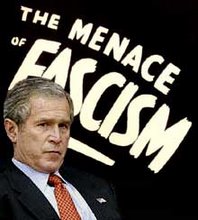So, what else is new?
Can any one group of people really be this incompetent, or are
their goals being met while stated U.S. policy goals go unmet?
U.S. Notes Limited Progress in Afghan War
Strategic Goals Unmet, White House Concludes
By Karen DeYoung
Washington Post Staff Writer
Sunday, November 25, 2007; A01
A White House assessment of the war in Afghanistan has concluded that wide-ranging strategic goals that the Bush administration set for 2007 have not been met, even as U.S. and NATO forces have scored significant combat successes against resurgent Taliban fighters, according to U.S. officials.
The evaluation this month by the National Security Council followed an in-depth review in late 2006 that laid out a series of projected improvements for this year, including progress in security, governance and the economy. But the latest assessment concluded that only "the kinetic piece" -- individual battles against Taliban fighters -- has shown substantial progress, while improvements in the other areas continue to lag, a senior administration official said.
This judgment reflects sharp differences between U.S. military and intelligence officials on where the Afghan war is headed. Intelligence analysts acknowledge the battlefield victories, but they highlight the Taliban's unchallenged expansion into new territory, an increase in opium poppy cultivation and the weakness of the government of President Hamid Karzai as signs that the war effort is deteriorating.
The contrasting views echo repeated internal disagreements over the Iraq war: While the military finds success in a virtually unbroken line of tactical achievements, intelligence officials worry about a looming strategic failure.
"There is a key debate going on now between the military -- especially commanders on the ground -- and the intelligence community and some in the State Department about how we are doing," said one Afghanistan expert who has consulted with the National Security Council as it continues to "comb through conflicting reports" about the conflict.
Over the past year, all combat encounters against the Taliban have ended with "a very decisive defeat" for the extremists, Brig. Gen. Robert E. Livingston Jr., commander of the U.S. task force training the Afghan army, told reporters this month. The growing number of suicide bombings against civilians underscores the Taliban's growing desperation, according to Livingston and other U.S. commanders.
But one senior intelligence official, who like others interviewed was not authorized to discuss Afghanistan on the record, said such gains are fleeting. "One can point to a lot of indicators that are positive . . . where we go out there and achieve our objectives and kill bad guys," the official said. But the extremists, he added, seem to have little trouble finding replacements.
Although growing numbers of foreigners -- primarily Pakistanis -- are joining the Taliban ranks, several officials said the primary source of new recruits remains disaffected Afghans fearful of opposing the Taliban and increasingly disillusioned with their own government.
Overall, "there doesn't seem to be a lot of progress being made. . . . I would think that from [the Taliban] standpoint, things are looking decent," the intelligence official said.
Senior White House officials privately express pessimism about Afghanistan. There is anxiety over the current upheaval in neighboring Pakistan, where both the Taliban and al-Qaeda maintain headquarters, logistical support and training camps along the Afghan border. But "in all honesty, I think it is too early to tell right now" whether political turmoil will undermine what U.S. officials already consider lackluster counterinsurgency efforts by Pakistani forces, the senior administration official said.
At the moment, several officials said, their concern is focused far more on the domestic situation in Afghanistan, where increasing numbers are losing faith in Karzai's government in Kabul. According to a survey released last month by the Asia Foundation, 79 percent of Afghans felt that the government does not care what they think, while 69 percent felt that it is not acceptable to publicly criticize the government.
Although 42 percent remained optimistic that things are moving in the right direction -- slightly lower than in a similar survey in 2006 -- most of those who thought otherwise cited insecurity as the biggest problem, followed by poor governance and the economy. Just a year ago, security was cited as the biggest reason for optimism.
U.S. troops number more than 25,000 and make up the largest contingent of the 41,000-member NATO force in Afghanistan. NATO officers say they have eliminated Taliban leaders and fighters in higher numbers than in any previous year. But such claims of success reflect "a very tactical outlook in a game that is strategic," said a former U.S. senior commander in Afghanistan who shares many of the intelligence community's concerns. "I have a lot of respect for [Taliban] strategy," he said. "These guys are not cowardly by any stretch of the imagination."
While U.S. and other NATO forces have maintained a firm hold on major cities, they have been unable to retain territory in the vast rural areas where 75 percent of Afghanistan's population lives, several sources said. Ground hard-won in combat has been abandoned and reoccupied by Taliban forces, which establish dominance over local governmental bodies.
There is widespread agreement among administration officials that the Taliban has suffered heavy losses this year. But the U.S. military has also suffered losses, with deaths already past the 100 mark, compared with 87 over all of last year -- making this the deadliest year for U.S. forces in Afghanistan since the war began. Afghan civilian deaths also reached an all-time high of 5,700 this year, according to an Associated Press tally.
The strategy is "clear, hold and build," said Seth Jones, an Afghanistan expert at the Rand Corp. "You clear the Taliban out, then you hold it for a period of time. You keep forces there, including Afghan forces, then you begin to build, then expand and go into neighboring districts. The problem has been that when you move troops into neighboring districts, you don't have enough to hold what you just cleared."
Although the competence of the Afghan army is improving by all accounts, U.S. military officials acknowledge that the goal of turning captured territory over to Afghan forces has been hampered by training delays and insufficient numbers.
In last year's Operation Medusa, Jones said, Canadian combat troops fought hard for control of the Panjwai district, south of Kandahar. "Four weeks ago," he said, "the levels of Taliban in Panjwai . . . were back up to pre-Operation Medusa."
Experts said the Taliban's control has extended beyond the group's traditional southern territory, with extremists making substantial inroads this year into the western provinces of Farah, Herat and others along the Iranian border even as they regularly challenge eastern-based U.S. forces.
"We're seeing definite expanded strongholds," said a U.S. official who declined to be identified by agency. "That's not going to stop in 2008. . . . If anything, it's gaining momentum."
Northern Afghanistan, ethnically separate from the Pashtun-dominated Taliban, is still considered relatively peaceful, although officials regard a Nov. 6 suicide bombing in northern Baghlan province that killed more than 8o people -- most of them children -- as an ominous sign. Though U.S. intelligence officials initially questioned the Taliban's denial of responsibility, they now believe the bomb was the work of Hezb-e-Islami, a Taliban ally, even as suspicion has grown in Afghanistan that most of the deaths were caused by Afghan police officers responding to the explosion.
The former senior U.S. commander said suicide attacks are a "hugely effective tactic" that has been imported from Iraq to Afghanistan, terrorizing the population and convincing Afghans that the coalition cannot protect them. "The idea that [suicide bombs] are a sign of desperation, that's ludicrous," he said.
In Washington, Afghanistan policy has often seemed to be on the back burner since the 2003 invasion of Iraq. Republican presidential candidates rarely discuss it, while Democrats generally bring it up to criticize the administration, saying officials are paying too much attention to Iraq at the expense of a "forgotten" war.
President Bush seldom mentions Afghanistan. In White House remarks last month asking Congress for an additional $200 billion for both wars, he noted that "our troops, NATO allies and Afghan forces are making gains against the Taliban," then offered an extensive recounting of progress in Iraq.
To the extent that the administration has publicly described problems in Afghanistan, it has focused on the reluctance of NATO members to send more troops and the restrictions placed by some on the missions they can undertake. "In Afghanistan, a handful of allies are paying the price and bearing the burdens" for the rest of the 26-nation group, Defense Secretary Robert M. Gates said at a NATO meeting last month. "The failure to meet commitments puts the Afghan mission -- and with it, the credibility of NATO -- at real risk."
Gates has acknowledged that U.S. Marine commanders have appealed to him to speed their departure from Iraq for deployment in Afghanistan to address more pressing challenges there. The Special Operations Command has also been lobbying for a more active role along the Afghanistan-Pakistan border.
Several experts believe that the United States can no longer afford to leave the Pakistani military to clean up its side of the border. "Unless we resolve the safe-haven issue, this is not going to succeed," said Henry A. Crumpton, a CIA veteran who led the agency's successful 2001 Afghanistan campaign against the Taliban and al-Qaeda. "It's getting worse."
But others said the problem is not Pakistan or a lack of military or financial resources in Afghanistan. It is the absence, they say, of a strategic plan that melds the U.S. military effort with a comprehensive blueprint for development and governance throughout the country.
"There are plenty of dollars and a hell of a lot more troops there, by a factor of two, from when I was there," the former commander said. The question, he said, is "who owns the overarching campaign for Afghanistan, and what is it?"
(In accordance with Title 17 U.S.C. Section 107, this material is distributed without profit to those who have expressed a prior interest in receiving the included information for research and educational purposes. I.U. has no affiliation whatsoever with the originator of this article nor is I.U endorsed or sponsored by the originator.)
The Nazis, Fascists and Communists were political parties before they became enemies of liberty and mass murderers.




